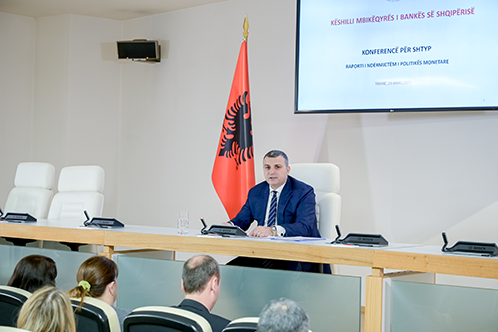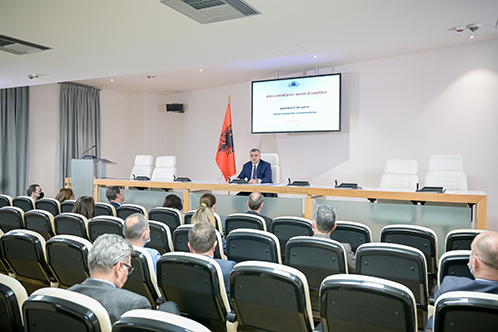BANK OF ALBANIA
PRESS RELEASE
Governor Sejko: Statement to the Press Conference on Monetary Policy Decision, 23 March 2022
Publication date: 23.03.2022
Dear Ladies and Gentlemen,
Today, 23 March 2022, the Supervisory Council of the Bank of Albania reviewed and approved the Intermediate Monetary Policy Report.

The Supervisory Council's discussions focused on the impact that the military aggression of Russia against Ukraine will have on the Albanian economy. Sanctions imposed on Russia and the heightened volatility and uncertainty affecting international markets have generated a new and challenging economic reality. This reality demands a revision of our previous projections and a re-evaluation on the adequacy of the monetary policy stance.
The geopolitical pressure will cause a twofold shock - directly on the supply side and indirectly on the demand side - on the Albanian economy. However, based on current analysis and projections, the Supervisory Council assesses that the Albanian economy will continue to grow in 2022 and beyond. This expectation is based on the vastness and strength of growth sources, assuming that the conflict will not evolve any further, as well as supposing that a combination of stimulating monetary and fiscal policies will continue to be implemented. On the other hand, the Supervisory Council assesses that inflation will remain above the Bank of Albania's target for most of the next two years.
Against this backdrop, the Supervisory Council decided to adapt the level of monetary stimulus in the economy. This adaption aims at establishing the necessary monetary conditions to: observe our inflation target; safeguard financial stability; and ensure the sustained and long-term growth of the economy and employment in Albania.
[I will now outline in more detail the main findings of the Report, our expectations for the future, and the reasons backing today's decision.]

***
The new data obtained suggest that the global economy is facing high prices of food, raw materials and commodities; a trend which is expected to persist. This shock will spillover to Albania as well.
Consumer price inflation increased in the first quarter. According to INSTAT, this inflation was 3.7% and 3.9% in January and February, respectively. Although official data is incomplete, the available information shows that prices will continue to rise in March.
Performance of inflation in Albania has been affected by higher prices in food and oil, coupled with the increased costs of production and transportation. In macroeconomic terms, the upward inflation trend reflects the fast and stable increase of demand, higher wages and employment, as well as the swift upsurge of prices in international markets, over the last two quarters. The latter were high in 2021 H2 and have been under increasing pressure due to the geopolitical tension that accompanies the conflict in Ukraine.
The upcoming price performance will be defined by the intensity and duration of this conflict, by its impact on prices and international trade, as well as by the stability of the economic growth in Albania.
The data derived from foreign markets signal that prices will continue to remain high over 2022 and 2023. These high prices will corrode the purchasing power of households and will be accompanied by a deceleration of the growth pace in a global scale. Consequently, global inflation projections over the succeeding two years are revised upwards, while economic growth projections are revised downwards. Also, most of central banks have accelerated their plans for normalising the monetary policy stance.
Against this backdrop, the Albanian economy has shown clear signs of recovery. The available data shows that, in the first quarter of the previous year, the economic activity has surpassed the level registered before the earthquake and the pandemic. Also, the data suggests that the positive growth moment has been carried over in the first two months of the current year as well.
Economic growth was broadly-based. This fall reflects the expansion across almost all sectors of economy and of the aggregate demand components. In macroeconomic terms, it was fuelled by: the improved confidence; a higher foreign demand; the favourable monetary and financial environment; and the fiscal stimulus of the past two years.
The stimulating monetary policy of the Bank of Albania has generated stable financial markets, low interest rates, and favourable financing conditions. Lending to the private sector increased by 11.8% in February, illustrating a growing support of consumer and investment funds. The climbing trend in lending was affected by the higher demand of households and enterprises, as well as the favourable lending policies adopted by the banking sector. This sector continues to be characterised by liquid and sound balance sheets and lower non-performing loans.
Our assessments suggest that the aggregate demand is generating an almost complete utilisation of capital and employment. The economic growth is reflected in the gradual increase of employment and the acceleration in the pace of wage hikes. In particular, INSTAT data show that employment increased by 2.1% in annual terms during 2021 Q4, whereas wages in the private sector were up by 10.2%. The high increase of wage rate suggests that the labour market is characterised by few unutilised capacities.
***
Medium-term forecasts update shows that the Albanian economy will suffer the effects of the shock. The upswing of prices in global markets and the reduction of foreign demand, will be accompanied by high inflation rates and a slower economic growth compared with our previous evaluations.
However, assessments in the baseline scenario suggest that the Albanian economy will continue to grow during 2022 and in the medium term. Also, our projections show that economic growth will remain in positive territory even if the shock results stronger than current assessments.
On the other hand, supply-side shocks and the stability of domestic demand are expected to engender higher inflation rates. According to the forecasts of the baseline scenario, inflation will hover around the 5-6% level for the remaining part of 2022. In addition, as international markets are expected to calm down, inflation is expected to fall during 2023 and return to target in the last quarter of the year.
***
Consistent to the above forecasts and previous communications, the Supervisory Council of the Bank of Albania deems it necessary to adapt the monetary policy stance to the new conditions in the economy.
Our monetary policy has been in quite a stimulating position during the past two years. It has aimed to drive aggregate demand during the pandemic, as a precondition in honouring our inflation target. The mission of this policy has been successful.
However, the current supply-side shock and the strength of aggregate demand, risk hindering our objective of price stability in the medium term.
Judging on the above, the Supervisory Council of the Bank of Albania decided to:
- Increase the policy rate by 0.5 percentage points, from 0.5% to 1.0%;
- Keep the overnight deposit rate at the current level of 0.1%;
- Increase the overnight lending rate, from 0.9% to 1.9%.
The Supervisory Council evaluates that - even after this movement - the current monetary policy stance continues to stimulate the growth of economy, employment, and wages. In the new reality, this stance provides a good balance between the risk of accelerating inflation and the risk of damaging economic recovery.
Judging on the current information, the normalisation of the monetary policy stance will be a gradual process underpinned by the new data.
However, the Supervisory Council observes that the balance of risks to inflation remains tilted to the upside. In this view, it will continue to monitor the reaction of the Albanian economy towards this shock, and will take all the necessary measures to observe our objective of price stability in the medium term.

 Twitter
Twitter
 Youtube
Youtube
 Facebook
Facebook
 Flickr
Flickr
 RSS
RSS
 Subscribe
Subscribe
 Feedback
Feedback